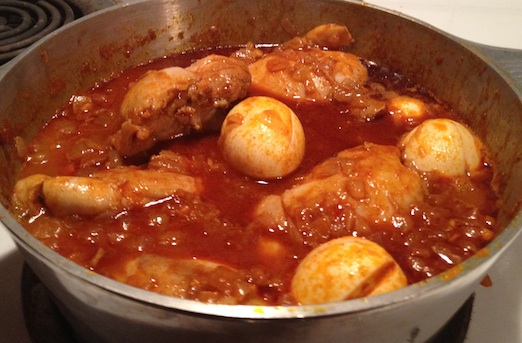Makes 6 servings
- 2 lb onion, finely chopped
- 2 cloves garlic, finely chopped
- 1 inch gingerroot, finely chopped
- ¼ cup clarified butter (see notes)
- 4 Tablespoons berbere (see notes)
- 6 chicken thighs of about ½ lb each, skinned, defatted and cut into strips (see notes)
- 4 hardboiled eggs, peeled (see notes)
- black pepper to taste
Special equipment
- large lidded stewpot or Dutch oven
Method
- Cook onions in a covered dry heavy stewpot over medium low heat until soft, about an hour. Ethiopian tradition excludes any additional liquid, whether oil or water, so stir occasionally to prevent browning. You may need to turn the heat down to low.
Stir in the garlic, ginger, and clarified butter, and cook for about 5 minutes until it sounds like it wants to scorch when you scrape the bottom of the pot.
Add the berbere, and stir a few minutes until pasty.
Now add the chicken pieces; stir to coat. Cover and turn down to the lowest possible simmer. Cook for 15 minutes.
Halve your eggs at their equators and bury them in the sauce. Cook another 15 minutes or until the chicken pieces are cooked through.
You may worry when you add the eggs that the sauce is too dry and that it wil burn. Don’t worry; your chicken will yield enough juice to prevent burning if you stir occasionally.
Remove the bones from the stew and scoup the remainder onto a warm serving platter. Sprinkle with fresh ground pepper. Ladle onto plate-sized wheels of injera bread.
Notes
-
Ethiopian tradition uses a spiced clarified butter or ghee called niter kebbeh, something you’d have on hand were you regularly cooking Ethiopian dishes, and something you’d never use again were you not. We compromised by using store-bought ghee and boosting the spicing of the rest of the recipe a bit.↩
The amount of berbere depends on its formulation, your tolerance for pepperiness, and whether you let the dish sit overnight before serving. Our berbere is a potent mixture direct from Ethiopia, and we’re likely to let it sit before serving or reheat as leftovers, so we use 4 Tablespoons or fewer.↩
Perhaps when our supply runs out, we’ll be forced to come up with our own formulation which we’ll then offer here. In the meantime, there are many versions available from spice emporia and recipes online. At this writing, one of our favoured spice shops has come out with their own formulation, but we haven’t taste-tested their formulation against our imported spice.
Traditional cooks would include one whole egg per serving (gashed a few times lengthwise to let them absorb the liquids spices), but carnivorous American appetite focuses more on the chicken, which is why we include fewer eggs here. Testing has shown that American diners will halve the eggs if you do not.↩
The traditional way to make this would be with a whole chicken cut up into many pieces. We use thighs to make the serving sizes consistent, but American chicken thighs are so huge, they need to be cut up into pieces. So we remove the meat from the bones and cut the thighs into strips. But we include the bones for flavor in the stew and remove them just before serving.↩
Suggestions
- The making of injera bread is an experience unto itself, as is using it instead of a plate and utenils. If you’re not up to the challenge just yet, serve your Wot with a steamed rice or crusty Italian bread.

